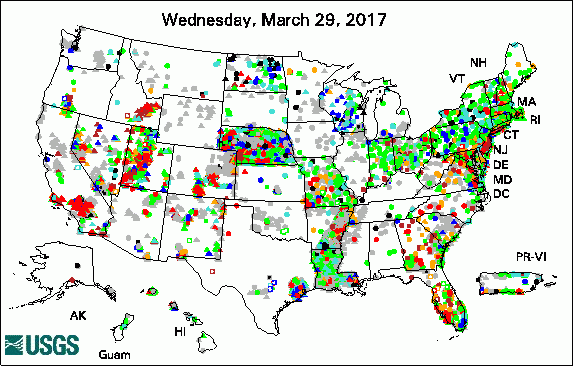USGS Groundwater Information
|
USGS Groundwater Information > May 1, 2017 Highlights USGS Monthly Groundwater News and Highlights: May 1, 2017Subscribe and get the latest USGS groundwater news and science sent to your inbox every month! Featured Product: USGS National Brackish Groundwater Assessment![Map: Predicted depth to brackish groundwater in the conterminous United States. [ Map: Predicted depth to brackish groundwater in the conterminous United States. ]](images/feature/20170501_PP1833-Fig12.jpg)
Predicted depth to brackish groundwater in the conterminous United States. Depths range from 500 to 3,000 feet below land surface. Source: Figure 12, USGS Professional Paper 1833. A new USGS assessment suggests that brackish groundwater could help stretch limited freshwater supplies. The amount of fresh or potable groundwater in storage has declined for many areas in the United States and has led to concerns about the future availability of water for drinking-water, agricultural, industrial, and environmental needs. Use of brackish groundwater could supplement or, in some places, replace the use of freshwater sources and enhance our Nation's water security. Learn more: USGS Groundwater-Related Press Releases 
The USGS Active Groundwater Level Network includes about 20,000 wells that have been measured by the USGS or USGS cooperators at least once within the past 13 months. The animation shows a daily snapshot of water-level statistics in the network for April 2017. Credit: USGS. The image is in the public domain. Media Advisory: Helicopter to Fly Low Over Cedar Rapids for Groundwater Study (04/27/17) Freshwater Ecosystems are an Important Part of the Alaskan Carbon Cycle (04/14/17) Wells Affect Water Flows in the Central Sands Region (04/06/17) New Map Shows How Groundwater Pumping Could Affect the Malad River (04/06/17) USGS Assessment of Brackish Water Could Help Nation Stretch Limited Freshwater Supplies (04/05/17)
USGS Groundwater-Related PublicationsChapter 1: Hydrologic exchange flows and their ecological consequences in river corridors (04/26/17) A groundwater-flow model for the Treasure Valley and surrounding area, southwestern Idaho (04/18/17) Brackish groundwater in the United States (04/13/17) Groundwater flow model for the Little Plover River basin in Wisconsin's Central Sands (04/11/17) Shallow bedrock limits groundwater seepage-based headwater climate refugia (04/04/17)
USGS Groundwater-Related Software Updates and New ReleasesCascade Routing Tool (CRT) v1.3.1
USGS Groundwater Flow and Transport Model Data ReleasesNote: The following links take you to data.gov Field PhotoDid you know USGS scientists use groundwater wells for more than just measuring depth to groundwater? For example, hydrogeologists can cause the water level in a well to change rapidly, and then measure how the water level in the well responds after that change. This is called a "slug test," which is a type of aquifer test that helps us quantify how groundwater is moving through the ground near the well. In this photo, USGS Hydrologist Phil Gardner is performing a slug test in Chicago Valley, California, with the Nopah Range in the background. The test was performed while collecting location data with Chris Morris of the USGS Nevada Water Science Center. The door on the ground is a to a vault that protects the opening of the well. The yellow tripod in the background is the GPS equipment for collecting highly accurate location information. Learn more about the USGS Nevada Water Science Center. Learn more about standard USGS groundwater field procedures, including slug tests. Archive of Past Highlights: |